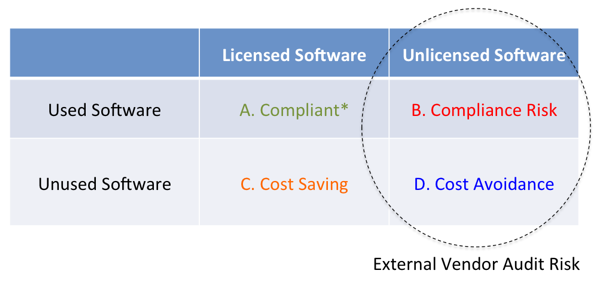Using True-Up Data to Build SAM Momentum
This is another article for beginners (See the others in the series here).
We discussed in ‘Our Software Licensing Is a Mess – Where do we Start?’ that we ought to use the 80/20 rule to select a low number of specific software vendors to focus on first. On the basis that by carefully picking some vendors, you make a massive impact to the control, costs and risks of your software estate in a fraction of the time it would take to gain control of the whole estate.
Getting Past the Repeat Vendor Audit Cycle
So lets assume you have begun to assemble the results of your first true up. If you want to go beyond the vicious vendor audit cycle and develop a valuable SAM practice you’ll need to quantify your return on effort.
A licensing reconciliation has three potential outputs:
- The software installed
- The software purchased
- The software being used (This assumes you are using an inventory tool with reliable software usage information).
From this we can develop four measurements as shown in the diagram below:
 (A) Compliant
(A) Compliant
The software installed is used and licensed correctly
This does not necessarily equate to efficiency (since users may have feature overlap with other products, redundancy or cheaper alternatives may be available)
(B) Compliance Risk
Software in use but not licensed.
Under licensed cost exposure – licenses need to be purchased. Risk of fines and disruption of external audit.
(C) Software Waste
Software purchased but not being used. If terms allow – remove software and stockpile licenses. Save money by not renewing maintenance on software that is not being used.
(D) Cost Avoidance
Unlicensed software not being used. If terms allow – remove software. Avoid spending money on new licenses on software that is not being used.
The £$ Benefit £$ of Being Proactive
If we are being proactive about our license reconciliation we only end up paying for B. If we are reactively responding to an external vendor audit then costs will be B+D (since for the most part, vendors don’t care if you are not using the software, nor do they provide a refund for C).
Our goal is to maximize A, eliminate B & D and retain a small surplus or minimize C. The success of your ongoing SAM program might be measured against the metrics in each one of these segments.
What To Do with The Data
The results are in and you have completed your reconciliation. This might result in identifying audit risk, potential savings or simply verification that things are ok.
Resist the urge to run to your IMAC team and start uninstalling software or making version changes.
If your reconciliation identifies something nasty, such as a $100K shortfall, it doesn’t mean you have to act on it right away. Let the information marinate – you have delivered the first tenet of SAM: visibility. We have moved the license compliance position of your vendor from ‘unknown’ to ‘known’.
We need to quantify the results and use them as leverage for change, service improvement and increasing the momentum in your SAM team.
Two things spring to mind here:
- Collect all possible SAM metrics for building business cases in the future
- Develop a SAM brag file
The SAM Brag File
When applying for a new job you may take a ‘brag file’ along with you to the interview to supplement your CV. It’s the file that has examples of your achievements, written statements from employers and other stuff that helps ‘sell’ yourself.
For your SAM team to grow – you need to develop a similar brag file.
Your brag file might contain sound bites, anecdotes, evidence, ROI, wins, whatever you want to call them. They are statements that make sure that when the concept of SAM is mentioned that savings, efficiency and effectiveness spring to mind. Make sure snippets from your brag file get mentioned in team meetings and company communications.
Senior management teams won’t remember all the intricacies of your licensing decisions – but they will remember the headline figures. Statements such as ‘This piece of work saved $100K’ and ‘that project saved us $50K’ get remembered well beyond the IT department.
The bottom line: By making wins memorable and continually demonstrating returns you can grow your SAM practice.
Can’t find what you’re looking for?
More from ITAM News & Analysis
-
Software Vendor Insights: What do the numbers tell us about the opportunities for ITAM negotiations?
What software vendor insights can be gained from the latest financial results from Amazon, Google, Broadcom, Salesforce, IBM and SAP? An important part of ITAM is paying close attention to the health of the companies we ... -
Flexera is first SAM tool vendor verified for Oracle E-Business Suite applications
Flexera has announced that it has been verified as the first software asset management (SAM) tool vendor for Oracle E-Business Suite applications. Almost anyone with an Oracle estate will be familiar with the company’s License Management ... -
ITAMantics - March 2024
Welcome to the March 2024 edition of ITAMantics, where George, Rich and Ryan discuss the month’s ITAM news. Up for discussion this month are. Listen to the full ITAMantics podcast above or queue it up from ...